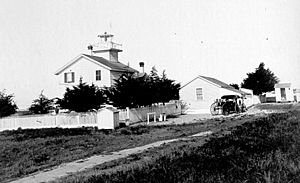Santa Cruz Surfing Museum facts for kids
 |
|||||||||||||||||||||||||||
| Established | 1986 | ||||||||||||||||||||||||||
|---|---|---|---|---|---|---|---|---|---|---|---|---|---|---|---|---|---|---|---|---|---|---|---|---|---|---|---|
| Location | Santa Cruz, California | ||||||||||||||||||||||||||
| Type | History | ||||||||||||||||||||||||||
| Visitors | 70,000 visits annually | ||||||||||||||||||||||||||
|
|||||||||||||||||||||||||||
The Santa Cruz Surfing Museum is a cool place that teaches you all about surfing history. It opened in May 1986. This museum shows how surfing started and grew in Santa Cruz, California. It has collections from the very first days of surfing on the mainland United States.
Where the Museum Is
The Santa Cruz Surfing Museum is located inside the Mark Abbott Memorial Lighthouse. You can find it at Lighthouse Point on West Cliff Drive. The museum first opened its doors in June 1986. It was the first surfing museum in the world.
The lighthouse itself was built in 1967. It was created to remember a surfer named Mark Abbott. He sadly passed away while surfing at a nearby spot called Pleasure Point.
This small museum looks out over Steamer Lane, a famous surfing spot. It displays many photographs, surfboards, and videos. These items show over 100 years of surfing history in Santa Cruz. After some money cuts in 2009, the Santa Cruz Surfing Club Preservation Society and private donations helped keep the museum open.
What You Can See Inside
The museum's exhibits explore more than a century of surfing in Santa Cruz. Surfing first came to Santa Cruz in 1885. Three Hawaiian princes introduced it. They surfed the mouth of the San Lorenzo River on special plank boards. Since then, surfing has become a big part of the Santa Cruz community.
A special plaque was put up in April 2010. It honors these three princes: David Kawānanakoa, Edward Abnel Keliʻiahonui, and Jonah Kūhiō Kalanianaʻole. Jonah later became a delegate to the US Congress.
Over the years, surf culture has changed with popular trends. Photos show how surfing culture grew in Santa Cruz. This includes the fun summers of the 1930s and 1940s. It also covers the "hipster" beach parties of the 1950s. Then came the surf rock music of the 1960s. The "soul surfing" style was popular in the 1970s. The bright neon colors were big in the 1980s. Finally, classic long-board riding became popular again in the 1990s.
You can see examples of surfboards from each time period. There are huge hollow paddle boards and redwood planks. These were made and ridden in the 1930s and 1940s. You can also see early foam and fiberglass boards. Plus, there are speedy short boards. These were used to create cool new surf moves starting in the 1970s.
History of the Lighthouse
The museum is located inside the current Santa Cruz Light. This light marks Point Santa Cruz. It is on the west side of the Santa Cruz Anchorage.
The first lighthouse was one of many California coastal lights. Congress approved money for it in 1850. This was just 19 days after California became a state. However, there were arguments over who owned the land. So, building did not start until 1868. The first light was a two-story wooden building. It had a lantern with a fifth-order Fresnel lens inside.
The land at Point Santa Cruz started to wear away. Because of this, the lighthouse had to be moved back 300 feet in 1879. Around 1909 (some sources say 1913), the lens was changed. A fourth-order Fresnel lens was put in. This made the light easier to see against the city lights. The light got electricity in 1917. It was replaced by a wooden tower in 1941. The original building was taken down in 1948.
See also
- List of lighthouses in the United States





